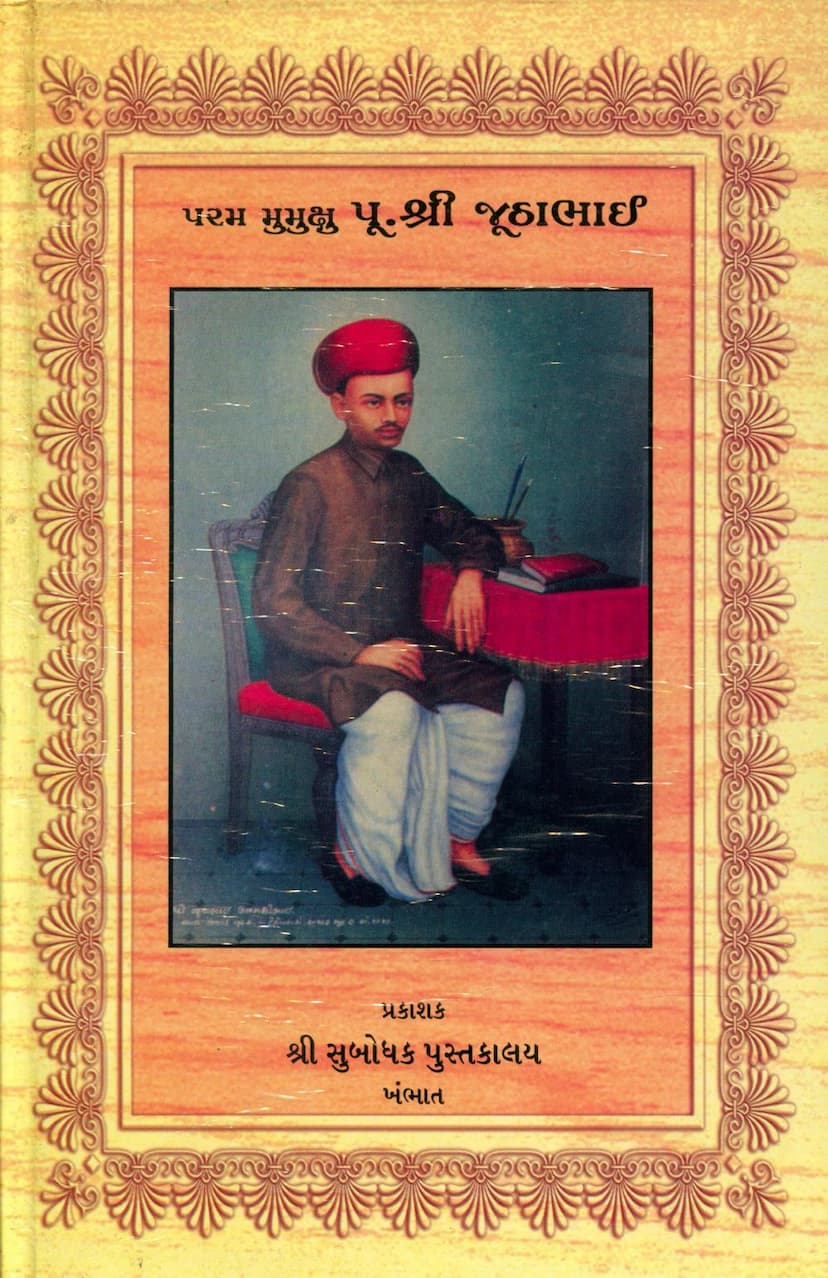Param Mumukshu Juthabhai
Added to library: September 2, 2025

Summary
This document is a biographical sketch of Pujya Shree Juthabhai, also known as Satyaparayan, a prominent Jain spiritual seeker (Mumukshu). It was published by Shri Subodhak Pustakalay, Khambhat, and compiled by Bhavaprabhaji Maharaj Saheb.
Here's a breakdown of the key information presented:
Introduction and Purpose:
- The book is a tribute to Pujya Shree Juthabhai, a "Param Mumukshu" (one with a supreme desire for liberation).
- It was inspired by a previous publication about Pujya Shree Ambalalbhai and a suggestion to document the life of another significant spiritual seeker, Juthabhai.
- The aim is to share the devotional life and experiences of Juthabhai with other spiritual seekers.
Pujya Shree Juthabhai (Satyaparayan):
- Born in Vikram Samvat 1923 (1866 CE) in Ahmedabad, into the prosperous Seth Malichand Jethachand family of the Dashashrimali Jain community.
- His father was Ujamshibhai and his mother was Jamnabai.
- He was described as humble, virtuous, intelligent, discerning, and possessing a gentle demeanor with a radiant face.
- Even in his youth, he was inclined towards spiritual seeking rather than worldly pleasures or games.
- He had a deep inner seriousness and a strong resolve to achieve self-realization in this very life.
Education and Early Spiritual Inclinations:
- He completed five years of Gujarati education and four years of English education, enabling him to converse in English.
- From the age of seven to fourteen, he studied.
- He was a year older than Shrimad Rajchandra (P.K. Dev).
- Despite being born into a Jain family, his spiritual inclinations led him to associate with a Vaishnava friend and participate in their devotional gatherings, keeping it a secret from his family.
- His family, particularly his father, eventually steered him back towards Jainism, emphasizing its compassionate nature. He was introduced to the teachings of Mahasatiji Diwali Bai.
Family and Household Life:
- His family was well-off, with his father involved in the textile business.
- He married Ugriben, the daughter of Manganlalbhai of Kalol, around Vikram Samvat 1939 (1882 CE) at the age of fifteen or sixteen.
- Despite being married, his mind was detached from worldly life. His wife, Ugriben, was also spiritually inclined and supported his path.
- His elder brother, Jethabhai, managed the family business, while Juthabhai remained detached from worldly affairs, concerned only with his spiritual progress and the cycle of birth and death.
Encounter with Shrimad Rajchandra (P.K. Dev):
- P.K. Dev visited Ahmedabad in Samvat 1943 (1886 CE).
- Juthabhai first met P.K. Dev in Samvat 1944 (1887 CE) at the home of Seth Jethabhai. This meeting was profoundly impactful.
- He was deeply impressed by P.K. Dev's profound knowledge, spiritual presence, and the miracles he performed (like the Ashtavadhan performance).
- P.K. Dev recognized Juthabhai's spiritual potential and bestowed upon him the name "Satyaparayan" (devoted to truth).
- Their relationship deepened through various encounters and extensive correspondence. P.K. Dev wrote numerous letters to Juthabhai, offering spiritual guidance, solace, and encouragement.
Spiritual Journey and Relationship with P.K. Dev:
- Juthabhai's letters to P.K. Dev reveal his intense longing for spiritual discourse and the divine presence.
- He saw P.K. Dev as his true Guru and savior, the one who could ferry him across the ocean of existence.
- He suffered from illness (fistula operation) during this period, but P.K. Dev's letters offered him spiritual strength and guidance to remain steadfast.
- The book highlights the profound spiritual bond between Juthabhai and P.K. Dev, quoting numerous letters exchanged between them.
- P.K. Dev often inquired about Juthabhai's health and encouraged him to maintain his spiritual practice even amidst physical suffering.
- Juthabhai's strong faith and devotion to P.K. Dev are evident in his willingness to serve and follow his guidance. He even facilitated the publication of P.K. Dev's "Mokshamala."
Later Life and Demise:
- Juthabhai's health deteriorated in Samvat 1945-46 (1888-1889 CE).
- Despite his physical weakness, his spiritual resolve remained strong.
- P.K. Dev visited him during his illness, providing him with profound spiritual teachings and the ultimate solace.
- Pujya Juthabhai (Satyaparayan) attained liberation (moksha) on Ashadh Sud 9, Samvat 1946 (1889 CE) at the age of 23, having achieved his spiritual goals in a short life.
- His life is described as a testament to the power of devotion and the grace of a true spiritual master.
Legacy:
- The book emphasizes that Juthabhai's spiritual journey and his devotion to P.K. Dev were instrumental in paving the way for the spiritual awakening of many, including Pujya Ambalalbhai and the residents of Khambhat.
- His brother, Seth Jethabhai, continued to uphold the family's spiritual values and dedicated his life to serving P.K. Dev, eventually establishing the Shrimad Rajchandra Gurumandir in Ahmedabad in his memory.
- The publication aims to inspire readers to follow in the footsteps of such great souls.
In essence, the book is a devotional biography celebrating the profound spiritual yearning and devoted life of Pujya Shree Juthabhai (Satyaparayan), highlighting his deep connection with Shrimad Rajchandra and his ultimate attainment of liberation.